LG Bundle
How did a South Korean chemical company become a global tech giant?
Embark on a fascinating journey through the LG SWOT Analysis, a story of innovation and transformation. From its humble beginnings in 1947 as Lak-Hui Chemical Industrial Corp., the LG company has consistently redefined the landscape of consumer electronics. Discover how this South Korean powerhouse, now known as LG corporation, evolved into a global leader.
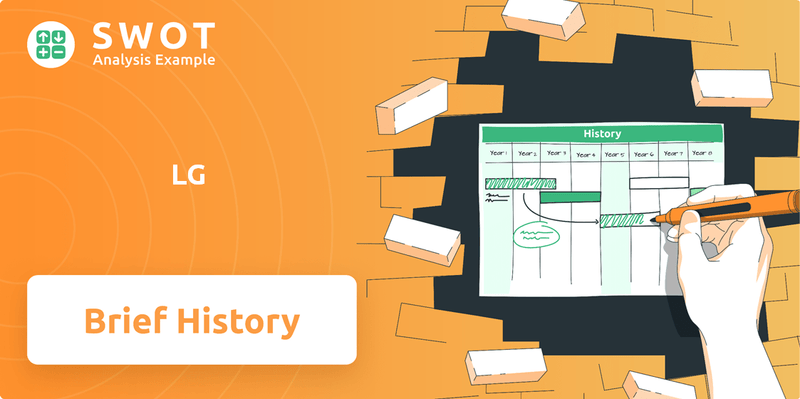
The brief history of LG showcases a remarkable evolution, marked by strategic diversification and a relentless pursuit of technological advancement. Understanding LG's founding story and its early products provides valuable insights into its current success. Explore LG's major milestones, global expansion, and its significant impact on consumer electronics, revealing the secrets behind the LG brand's enduring legacy.
What is the LG Founding Story?
The LG company, a global powerhouse in consumer electronics and beyond, has a rich history rooted in post-war South Korea. Its journey began on October 1, 1947, with the founding of Lak-Hui Chemical Industrial Corp. by Koo In-hwoi in Seoul. This marked the inception of what would evolve into the LG corporation, a testament to entrepreneurial vision and adaptability.
Koo In-hwoi's foresight led him to establish a chemical company, recognizing the critical need for essential goods in a nation striving to rebuild after the war. The company's initial focus was on plastic products, with its first product being a plastic cream container. This innovative move highlighted the company's early commitment to providing solutions in a market where such materials were scarce. This early focus set the stage for the company's future diversification and growth.
The foundation of Lak-Hui Chemical Industrial Corp. was built upon Koo In-hwoi's personal capital and early investments. The company's name, Lak-Hui, which translates to 'prosperous harmony,' reflected the founder's aspirations for a successful and harmonious enterprise. The company’s establishment was deeply influenced by the post-World War II era in Korea, a time of intense industrialization and a drive for self-sufficiency. This environment provided the perfect conditions for entrepreneurs like Koo In-hwoi to lay the groundwork for a major conglomerate. Read more about the Marketing Strategy of LG.
The LG history began with Lak-Hui Chemical Industrial Corp. in 1947, founded by Koo In-hwoi.
- The company's initial focus was on producing plastic products, with a plastic cream container as its first offering.
- The name Lak-Hui, meaning 'prosperous harmony,' reflected the founder's vision.
- The founding was influenced by post-war Korea's drive for industrialization and self-sufficiency.
- The company's early funding came from Koo In-hwoi's personal capital and early investments.
LG SWOT Analysis
- Complete SWOT Breakdown
- Fully Customizable
- Editable in Excel & Word
- Professional Formatting
- Investor-Ready Format
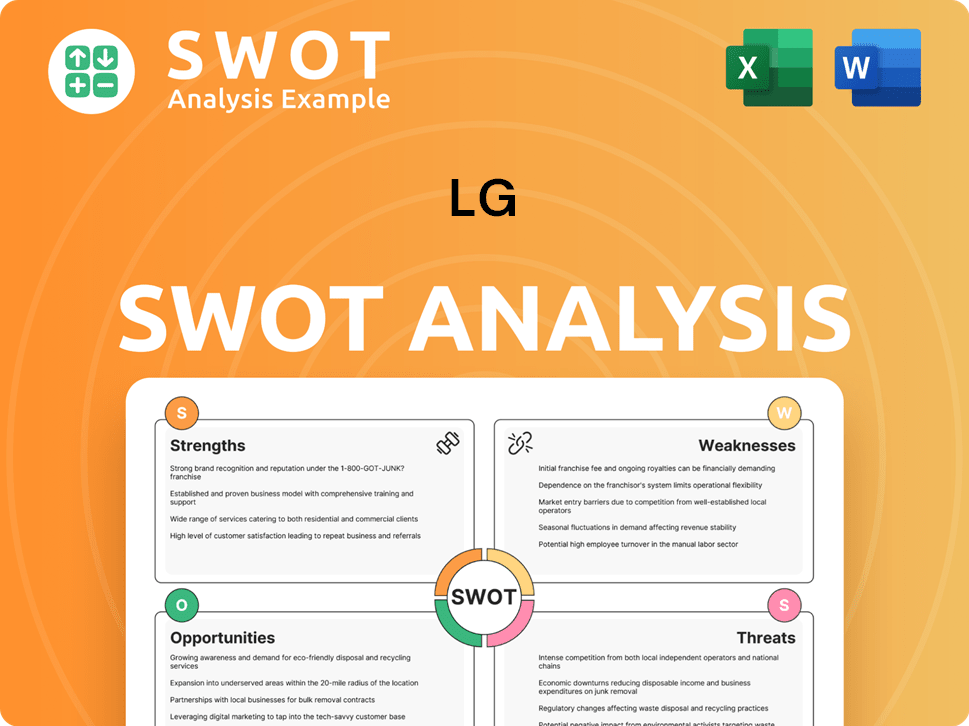
What Drove the Early Growth of LG?
The early growth of the company, now known as the LG brand, was marked by significant expansion and diversification. Initially focused on chemicals, the company quickly moved into plastics and later, electronics. This strategic shift laid the foundation for its transformation into a major player in the global market.
The company's early diversification beyond plastic cream containers was a key strategy. In 1952, it became the first Korean company to produce plastic molding machines, enhancing its position in the plastics industry. This expansion set the stage for a more significant move into electronics. The company's ability to adapt and innovate was crucial during this period.
In 1958, the company established GoldStar Co., Ltd., marking its entry into the South Korean electronics market. This was a pivotal moment, capitalizing on the growing consumer demand for electronics. GoldStar's entry into electronics was a strategic move that would define the future of the
GoldStar's first major product was Korea's first domestically produced radio in 1959, a significant milestone. This was followed by the production of the first Korean refrigerator in 1965 and the first black-and-white television in 1966. These early products helped establish the company's reputation for innovation. These products were essential for the
Early team expansion focused on engineers and technicians crucial for product development and manufacturing. Initial office and facility locations were primarily in Seoul and Busan, strategically chosen for their industrial potential. The company's entry into new markets was initially driven by meeting domestic demand, but it soon looked towards international expansion. By the 1970s, GoldStar products began to be exported, laying the groundwork for LG's global footprint.
LG PESTLE Analysis
- Covers All 6 PESTLE Categories
- No Research Needed – Save Hours of Work
- Built by Experts, Trusted by Consultants
- Instant Download, Ready to Use
- 100% Editable, Fully Customizable
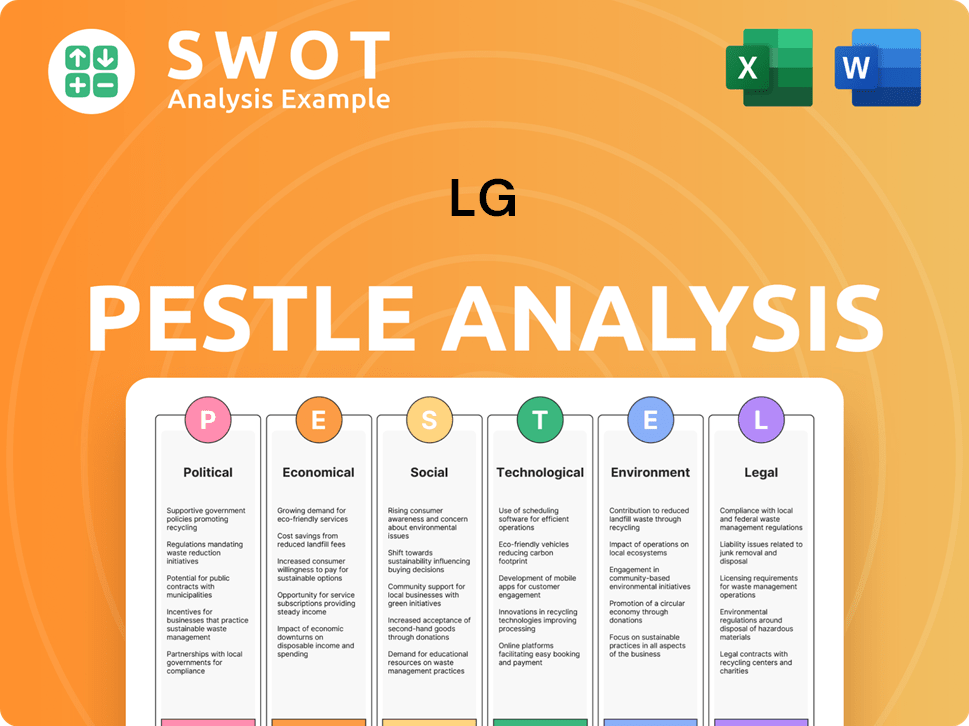
What are the key Milestones in LG history?
The LG history is marked by significant milestones that showcase its evolution from a local manufacturer to a global LG corporation. The LG company has consistently expanded its product lines and market presence, establishing itself as a major player in the consumer electronics industry and beyond.
| Year | Milestone |
|---|---|
| 1958 | Founded as GoldStar, initially focusing on the production of radios. |
| 1977 | Developed Korea's first color television, marking a significant technological advancement. |
| 1995 | The company was rebranded from Lucky-GoldStar to LG group, reflecting a broader global strategy. |
| 1998 | Launched the world's first 60-inch plasma TV, demonstrating its commitment to display technology innovation. |
| 2021 | Announced its exit from the smartphone business, a strategic move to focus on growing sectors. |
Throughout its history, LG electronics has consistently pushed the boundaries of technological innovation. The LG brand has invested heavily in research and development, leading to numerous patents and groundbreaking products.
LG has been a pioneer in display technology, with innovations in OLED and LCD panels. These advancements have significantly improved picture quality and energy efficiency in televisions and other devices.
LG has introduced smart home appliances with features like AI-powered washing machines and refrigerators. These innovations enhance user convenience and energy efficiency.
LG was a key player in the early mobile phone market, developing innovative designs and features. The company's efforts in 5G technology have been notable.
LG's development and commercialization of OLED (Organic Light Emitting Diode) technology have revolutionized display quality. OLED displays offer superior contrast, color accuracy, and viewing angles compared to traditional LCDs.
LG has focused on integrating its products into smart home ecosystems, allowing for seamless control and automation. This includes voice control via platforms like Google Assistant and Amazon Alexa.
LG has expanded into the electric vehicle (EV) components market, supplying batteries, displays, and other components. This strategic move positions LG in a rapidly growing sector.
Despite its successes, LG company has faced numerous challenges throughout its history. Market competition and economic downturns have required strategic adjustments and restructuring.
Intense competition from both domestic and international rivals has consistently pressured LG to innovate. Companies like Samsung and other global brands have provided strong competition in key markets.
The Asian financial crisis in the late 1990s and other economic challenges have necessitated restructuring efforts. These events have required LG to adapt its strategies and operations.
LG faced difficulties in the smartphone market, struggling to gain significant market share against competitors. This led to the strategic decision to exit the smartphone business in 2021.
LG has made strategic pivots, such as exiting the smartphone market and focusing on EV components and smart home solutions. These moves reflect a commitment to adapting to market changes.
Global supply chain disruptions, particularly those experienced in the early 2020s, have impacted LG's production and distribution. The company has worked to diversify its supply chains and mitigate risks.
Evolving consumer preferences and technological shifts require continuous innovation and adaptation. LG must stay ahead of trends to maintain its competitive edge.
LG Business Model Canvas
- Complete 9-Block Business Model Canvas
- Effortlessly Communicate Your Business Strategy
- Investor-Ready BMC Format
- 100% Editable and Customizable
- Clear and Structured Layout
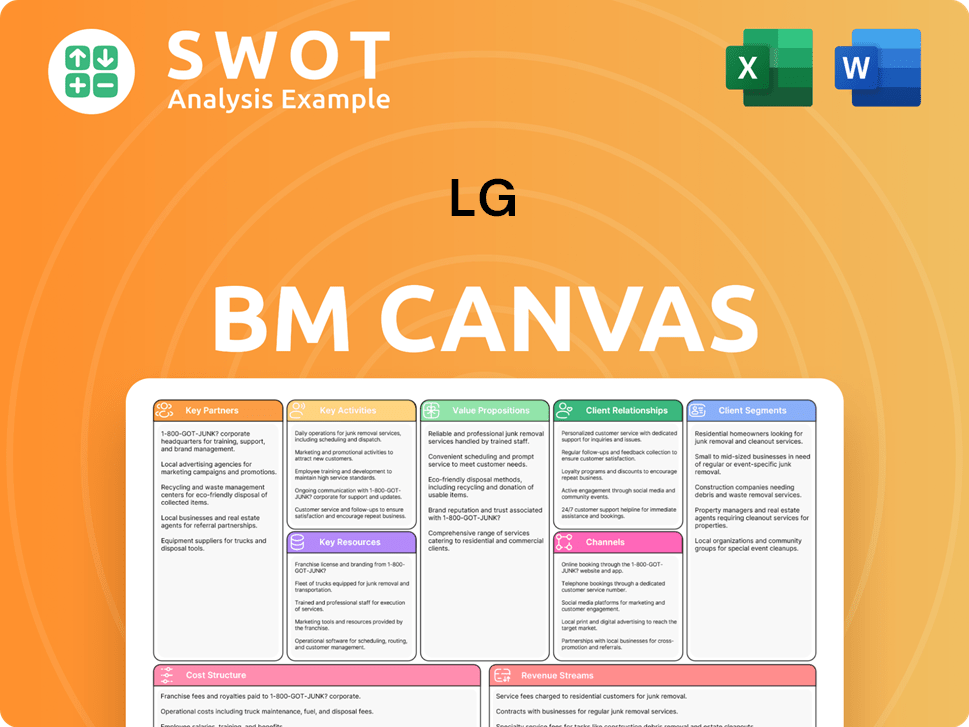
What is the Timeline of Key Events for LG?
The LG history is a story of innovation and transformation. It began in 1947 with the establishment of Lak-Hui Chemical Industrial Corp. The
| Year | Key Event |
|---|---|
| 1947 | Koo In-hwoi establishes Lak-Hui Chemical Industrial Corp. |
| 1958 | GoldStar Co., Ltd. is founded, marking entry into the electronics industry. |
| 1959 | Produces Korea's first radio. |
| 1965 | Produces Korea's first refrigerator. |
| 1966 | Produces Korea's first black-and-white television. |
| 1977 | Develops Korea's first color television. |
| 1995 | Lucky-GoldStar rebrands as LG. |
| 1998 | Develops the world's first 60-inch plasma TV. |
| 2004 | Launches the world's first 55-inch full HD LCD TV. |
| 2007 | Introduces the world's first full HD LCD TV with a 120Hz scanning rate. |
| 2013 | Unveils the world's first flexible OLED TV. |
| 2021 | Exits the smartphone business to focus on other growth areas. |
| 2024 | LG Electronics reports record high annual revenue of KRW 86.7 trillion (approximately USD 65.5 billion) in 2023, with a significant portion attributed to its home appliance and air solution business. |
| 2025 | LG continues to invest heavily in AI, robotics, and electric vehicle components, with a focus on smart life solutions and B2B expansion. |
LG is strategically investing in AI and robotics to enhance its smart home solutions. This involves developing advanced technologies to improve user experience and create new business opportunities. The goal is to integrate AI and robotics into various aspects of daily life.
The vehicle component solutions (VS) business is poised for significant growth, particularly in the electric vehicle market. LG aims to become a leading provider of automotive components, building on strong partnerships with global automakers. This sector is expected to be a key driver of future revenue.
LG is expanding its B2B operations, providing display solutions, HVAC systems, and other commercial products. This diversification into the business-to-business market is a strategic move to generate more revenue streams. The expansion includes providing innovative solutions for various industries.
Leadership emphasizes a commitment to 'customer value innovation' and sustainable growth. This focus on sustainability and customer satisfaction is central to LG's long-term strategy. The company aims to create products and services that improve lives while minimizing environmental impact.
LG Porter's Five Forces Analysis
- Covers All 5 Competitive Forces in Detail
- Structured for Consultants, Students, and Founders
- 100% Editable in Microsoft Word & Excel
- Instant Digital Download – Use Immediately
- Compatible with Mac & PC – Fully Unlocked
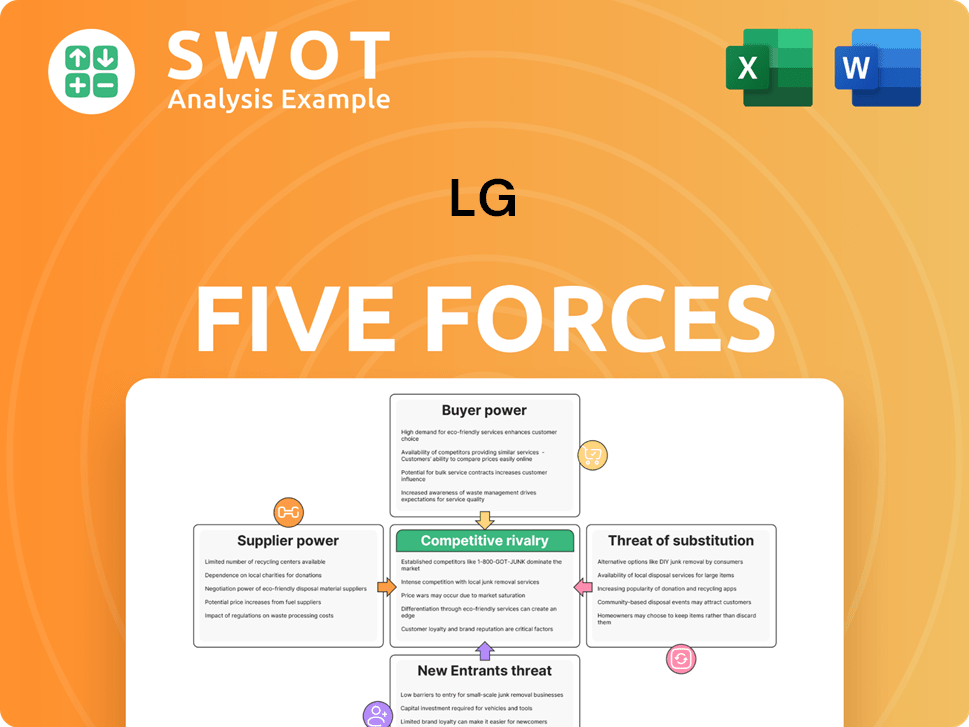
Related Blogs
Disclaimer
All information, articles, and product details provided on this website are for general informational and educational purposes only. We do not claim any ownership over, nor do we intend to infringe upon, any trademarks, copyrights, logos, brand names, or other intellectual property mentioned or depicted on this site. Such intellectual property remains the property of its respective owners, and any references here are made solely for identification or informational purposes, without implying any affiliation, endorsement, or partnership.
We make no representations or warranties, express or implied, regarding the accuracy, completeness, or suitability of any content or products presented. Nothing on this website should be construed as legal, tax, investment, financial, medical, or other professional advice. In addition, no part of this site—including articles or product references—constitutes a solicitation, recommendation, endorsement, advertisement, or offer to buy or sell any securities, franchises, or other financial instruments, particularly in jurisdictions where such activity would be unlawful.
All content is of a general nature and may not address the specific circumstances of any individual or entity. It is not a substitute for professional advice or services. Any actions you take based on the information provided here are strictly at your own risk. You accept full responsibility for any decisions or outcomes arising from your use of this website and agree to release us from any liability in connection with your use of, or reliance upon, the content or products found herein.